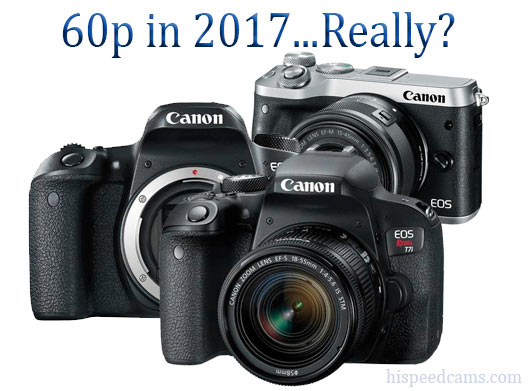Yesterday Canon unveiled the Canon EOS 77D, EOS T7i & the M6 Mirrorless. Al three are geared to photo enthusiasts and contain a video component that in some ways resembles the releases of other companies from 2014. The real improvement with these cameras comes in the way of dual pixel AF sensors that are able to track in video mode with precision.
The pricing on these cameras is very aggressive with the 77D @ $899.99 body only, T7i for $749.00 body only and M6 with 15-45mm lens for $899. You get a lot of still camera for your money and a somewhat competitive 1080p video camera with up to 60fps in that mode.
What about video and Slowmo?
Sadly there is not a lot to crave about the video modes on these cameras. 1080p 24, 25, 30 and 50p / 60p are all you get for frame rates. 120fps is absent here and 4k video which is supposed to be a given since mid 2016 on new cameras simply is a no show.
Canon does make nice bodies and their cameras have great AF for stills and now with the help of Dual Pixel AF they can track in video mode with much better results. It seems to be the same technology as the Canon EOS 80D which is now not such a good deal with the Canon 77D being so close specs wise and much cheaper. The EOS 7D Mark II is also in need of a refresh; which now looks ancient in video and even photo mode with an older sensor.
The new EOS 77D – by Canon Europe:
Canon needs to step up their game to remain relevant in the specs; their EOS 7D replacement needs 4k video and at least 120fps 1080p video in order to have some relevance against the competition. Dual Pixel AF in video mode should also be a given along with improvements in the codec. Getting away from Photo JPEG and getting back into H.264 or H.265 with 4:2:2 color space should do the line a lot of good. 4k 60p is now showing up in cameras like the Panasonic GH5 and that camera also shoots 180fps at 1080p.
Introducing the street-ready EOS M6 -by Canon Europe:
The new Canon releases simply remain pegged at performance levels from two years back. They look rounder, newer and have a few bells and whistles with refinements under the hood. Problem is that camera sales are dwindling due to over saturation and phone cameras. If Canon doesn’t offer a big increase in features to incite people to upgrade they will be in trouble sooner or later.
Our Video Wishlist for the EOS 7D Mark III:
- Dual Pixel AF Full Time in Video Mode Like 5D Mark IV
- 24MP Sensor instead of 20MP
- 4k 24,30p and 60p in H.264 Codec
- 120fps 1080p with higher fps possibility.
- Video Image Super-sampling from 6k to 4k.
- No Aliasing or Moire Problems
- Vari-Angle LCD Screen
- Canon Log Picture Style
- Peaking and Zebras
How much will the list above resemble the final 7D Mark III, sadly we thing very few features will make it into the final product. We expect the camera to remain a follower rather than a market segment leader. Canon seems to be just too conservative and geared to the stills side while protecting their Cinema pro video line.
CANON EOS 77D, EOS REBEL T7i and EOS M6: First Look with Alexis Stember Coulter by Adorama:
What should I do if I need a camera now?
If you are married to the Canon ecosystem we suggest you wait for the 80D replacement which should give you 4k video. If you can’t wait and have the means then the EOS 5D Mark IV is an option but with severe 4k crop in video mode. Frankly the two cameras you should be looking at are the Panasonic GH5 and Sony’s a6500 which offer modern features today. You can also continue to use your Canon glass with Metabones and other adapters like the Kippon. Also Sony should make a big splash with the a7s III low light full frame camera later this year. We are going to be very interested in this option when released and cover it fully.
If you only need a stills camera with 1080p video; all three of the Canon releases today will work fine for your needs, they will still take great images and 1080p videos. 4k and Slowmo users move right along – HSC

